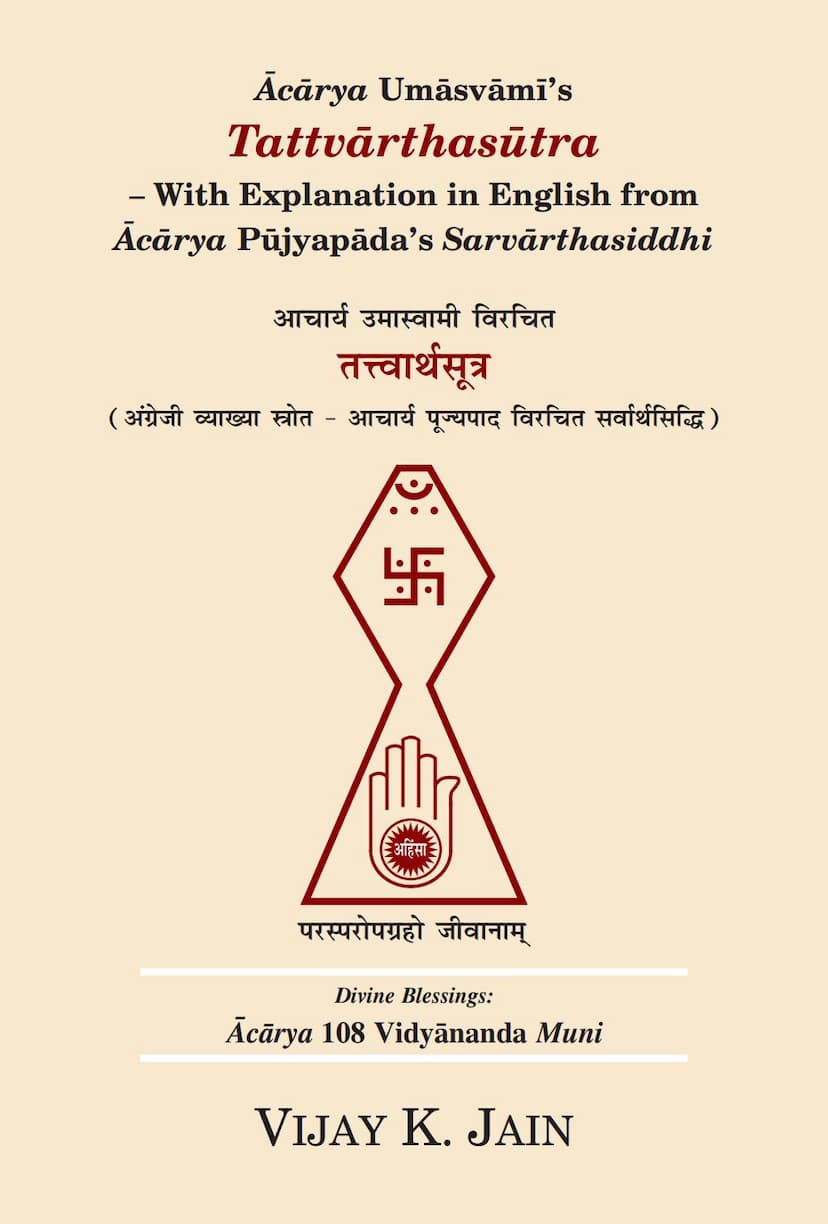Tattvartha Sutra
Added to library: September 2, 2025

Summary
The "Tattvārthasūtra" by Ācārya Umāsvāmī, with an English explanation sourced from Ācārya Pūjyapāda's "Sarvārthasiddhi," is a foundational text in Jain philosophy. This particular edition, translated and compiled by Vijay K. Jain, aims to make the profound teachings of Jainism accessible to a wider audience.
The work begins with divine blessings and an invocation, setting a spiritual tone. It highlights the core tenet of Jainism, "Parasparopagraho Jīvānām" (The function of souls is to help one another), as depicted on its cover. The book is presented as a non-copyrighted resource, encouraging its reproduction and translation.
The "Tattvārthasūtra" is structured into ten chapters, each delving into fundamental aspects of Jain doctrine. The English explanation, drawing from Ācārya Pūjyapāda's commentary, aims for clarity and comprehensibility. The preface emphasizes that the scripture is considered the word of the Omniscient Tirthankara and details the author's identity as Ācārya Gṛddhpiccha, also known as Umāsvāmī or Umāsvāti. It recounts the origin stories of the Tattvārthasūtra, highlighting its importance as "Mokşaśāstra" (Scripture on Liberation). The preface also enumerates key commentaries on the Tattvārthasūtra, including those by Samantabhadra, Pūjyapāda, Akalańka, and Vidyānanda, underscoring the profound philosophical and logical depth of the work.
The author, Vijay K. Jain, is noted for his extensive work in translating numerous Jaina texts into English, contributing significantly to the global understanding of Jainism. The foreword by Dr. Chakravarthi Nainar Devakumar praises Jainism's philosophical insights, including concepts on soul, knowledge systems, multiverse, and the path to liberation, suggesting their relevance to modern scientific research. The book itself is described as a masterpiece, retaining Sanskrit terms for clarity and enriching the English lexicon with Jain vocabulary.
The Tattvārthasūtra systematically outlines the Jain path to liberation (mokṣa). The first chapter focuses on Right Faith and Knowledge, defining them as integral components of the path to liberation. It elaborates on the nature of right faith and knowledge, and the means to attain them.
The second chapter, Category of the Living, discusses the nature of the soul (jīva), its various dispositions arising from karmas (pārināmika, audāyika, kṣāyika, etc.), and its different states of existence. It details the classification of souls into transmigrating (samsārī) and liberated (mukta), further categorizing transmigrating souls based on senses (trasa and sthāvara), and the types of bodies they possess.
Chapter three, The Lower World and the Middle World, describes the structure of the universe according to Jain cosmology. It details the seven infernal earths (adholoka) and their inhabitants, the infernal beings (nāraka), their suffering, and their lifespan. It then shifts to the middle world (madhyaloka), describing its geography, including the continents and oceans, the central Mount Meru, the various regions (kṣetra), and the human inhabitants of these regions, their lifespans, and the cyclical nature of time (utsarpiņi and avasarpini).
Chapter four, The Celestial Beings, categorizes the celestial beings (deva) into four classes: residential (bhavanavāsi), peripatetic (vyantara), stellar (jyotisha), and heavenly (vaimānika). It discusses their lifespans, their various subdivisions, their nature of enjoyment, and their thought-colourations (leśyā). It also provides details on the structure of the universe and the celestial abodes.
Chapter five, The Non-Living Substances, delves into the nature of ajīva (non-soul) substances: medium of motion (dharma), medium of rest (adharma), space (ākāśa), matter (pudgala), and time (kāla). It explains their characteristics, their pervasiveness, their atomic and molecular structures, and their functions in the universe.
Chapter six, Influx of Karmas (Āsrava), details the process by which karmic particles attach to the soul. It explains that activities of the body, speech, and mind (yoga), influenced by passions (kaşāya) and wrong-belief (mithyādarśana), lead to the influx of auspicious (punya) and inauspicious (pāpa) karmas. It further elaborates on the specific causes for the influx of various types of karmas, including those related to knowledge, perception, feelings, delusion, lifespan, physique, status, and obstruction.
Chapter seven, The Five Vows, focuses on the ethical conduct prescribed for the householder and ascetics. It defines the five major vows (mahāvrata) – non-injury (ahimsā), truthfulness (satya), non-stealing (asteya), chastity (brahmacarya), and non-attachment (aparigraha) – and their fivefold observances (bhāvanā) for strengthening them. It also describes the transgressions (aticāra) associated with these vows and supplementary vows, and the practice of sallekhanā (a form of pious death).
Chapter eight, Bondage of Karmas (Bandha), elaborates on how karmas bind the soul. It identifies the causes of bondage as wrong-belief, non-abstinence, negligence, passions, and activities. It details the fourfold bondage (prakṛti, sthiti, anubhāva, pradeśa) and the subdivisions of each of the eight main types of karmas. The chapter also explains the concepts of merit (punya) and demerit (pāpa) karmas.
Chapter nine, Stoppage (Samvara) and Shedding (Nirjarā) of Karmas, describes the processes that lead to liberation. Stoppage (samvara) is achieved through control (gupti), carefulness (samiti), virtue (dharma), contemplation (anuprekşā), conquest of afflictions (parīṣahajaya), and conduct (cāritra). It details the numerous subdivisions of these means and the specific afflictions (parīṣaha) that ascetics endure. Austerity (tapa) is highlighted as a crucial means for both stoppage and shedding.
Chapter ten, Liberation (Mokşa), explains the ultimate goal of Jainism. It describes how liberation is attained through the destruction of all karmas, particularly delusion (moha) and the destructive karmas. It clarifies that while the soul is freed from karmic bondage, it retains its inherent pure nature of infinite knowledge, faith, perception, and bliss. The text describes the upward movement of the liberated soul to the end of the universe and its eternal state of perfection. It also discusses the differentiations among liberated souls based on various factors.
The book concludes with an epilogue and the "Tattvārthasūtra Reader," which lists the sūtras in Sanskrit and IAST transliteration for easy reference. It also includes a section on the transliteration guide and lists of other Jain texts published by Vikalp Printers, showcasing the author's broader contribution to making Jain scriptures available in English. The overall presentation is comprehensive, aiming to provide a clear understanding of the Tattvārthasūtra's profound teachings on the nature of reality and the path to spiritual liberation.